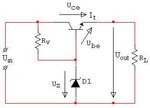blapcb
Full Member level 3
- Joined
- Jan 7, 2007
- Messages
- 188
- Helped
- 2
- Reputation
- 4
- Reaction score
- 0
- Trophy points
- 1,296
- Location
- Planet earth (most of the time)
- Activity points
- 2,766
Hi. I am trying to make a circuit that will accept a voltage from 0 to 30v and limit it to 3.3v as a TTL input to my microcontroller. I am using a "classical" (i.e. often used, so I understand) design of two Schottky diodes in series (attached). In LT Spice simulation the voltage is approx 3.4v at the junction of R1/D1/D2. But in real life when I build the circuit, I get voltages all across the board all the way up to a limit of 5.7v for an input above 20v (where it seems to finally stop). Why is it not just staying at 3.4v like in the simulation? Thanks.


